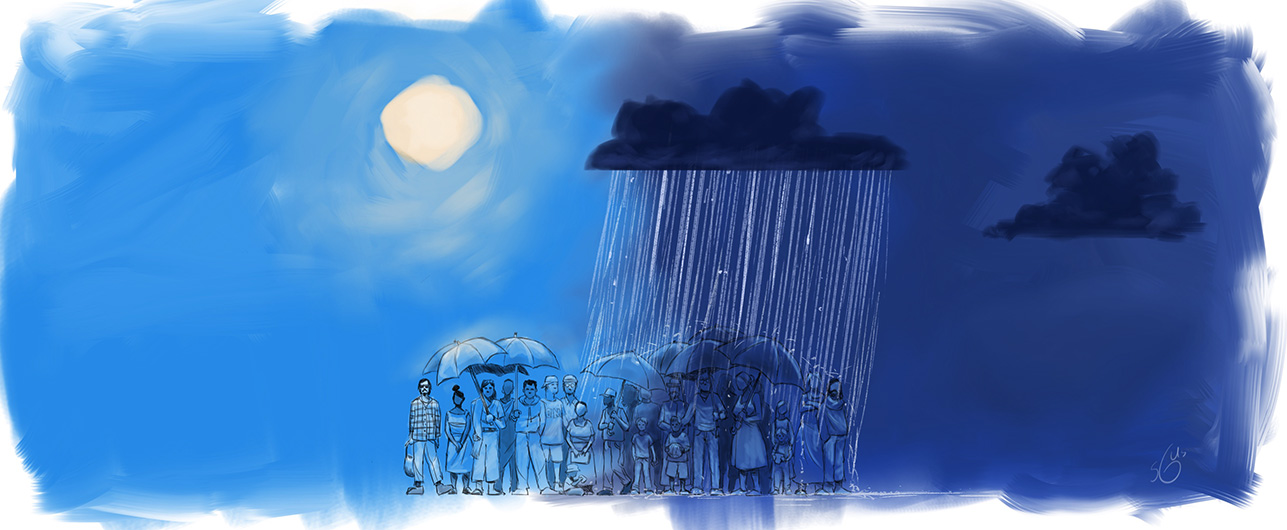
14 Oct 2022
What happens when 1000-year disasters happen yearly?


We now live in a world where scorching temperatures and blazing wildfires have become the new norm. Warmer oceans have increased the strength of hurricanes in Florida. Nearly 14 million people will live in areas of Amsterdam that will be vulnerable to flooding by 2050. Last March, India recorded its highest temperature in 122 years and experienced a rainfall deficiency of 72%.
Disasters are not just getting more common, though. Regions are encountering natural disasters that they wouldn’t have seen in the past, a pattern induced by climate change: fires rage in London, Texas is often below freezing, and Pakistan is underwater. Nations are facing catastrophes that are new to them, and that they aren’t equipped to battle.
📍Greater London, United Kingdom: Wildfires
In June and July 2022, Europe and the Mediterranean suffered record high temperatures as a series of wildfires swept through France, Portugal, Spain, and England.
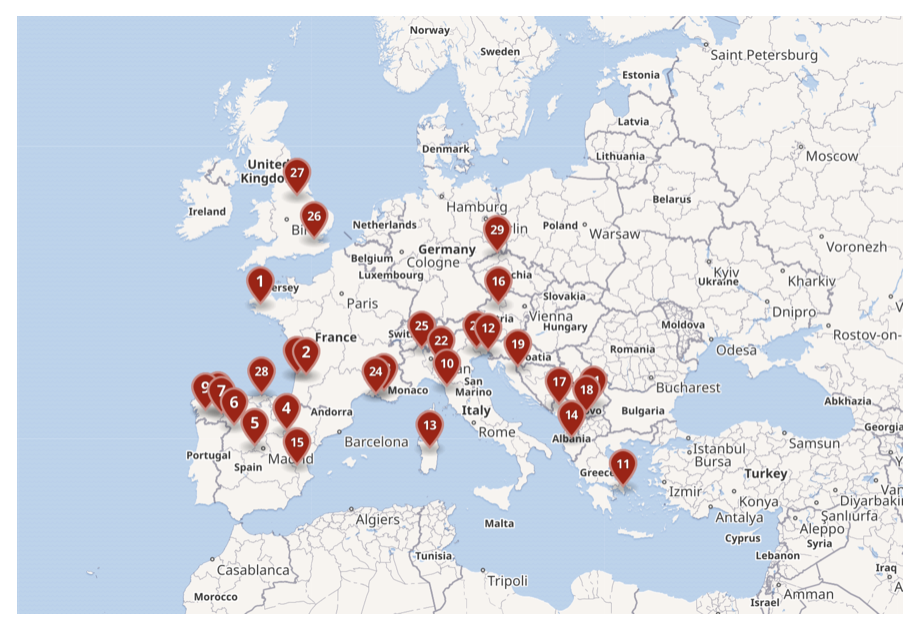
Map of Wildfires in Europe Since July 19, 2022. Source: European and Mediterranean Wildfires 2022
Europe will see significant warming, dramatically increasing the chances of wildfires. European nations must prepare and learn from regions that deal with recurrent seasons of wildfires: prevention, process, staffing, and equipment.
Costs of Adaptation
On July 19th, 2022, London reported extreme temperatures of 104°F, leading to extensive wildfires in East London. The London Fire Brigade explained it was the busiest day since World War II. The number of fires has increased significantly since 2010 and will continue to become more frequent as temperatures rise. The National Fire Chiefs Council reported a total of 442 wildfires by August 2022 compared to 247 wildfires in all of 2021.
While wildfires are a newer challenge for the UK, the United States and states such as California have best-practices that the UK can adopt. The US has established the National Interagency Fire Center which coordinates state and federal level response and finance. In contrast, the UK does not have a national wildfire agency. Instead, multiple government organizations oversee wildfire management and there is a fragmentation of policies at the local and national levels. Local policies are often reactive and national policies are broad, so there is an urgent need to introduce more explicit policies to overcome the potential severity of wildfires.
The United States experiences frequent wildfires, especially in the western part of the country. In response to growing severity of fires, the US Forest Service and Department of the Interior have dramatically increased their spending, with over $4.4B spent on fire suppression alone in 2021. Data from the National Interagency Fire Center shows that fire suppression costs an average of $312 per acre, with significantly higher costs ($615 per acre) in years with extreme fire behavior. As the climate warms and fires become more frequent, intense, and cover more ground, there is a corresponding increase in suppression costs. It would be surprising if firefighting costs in the UK didn’t follow the same trend.
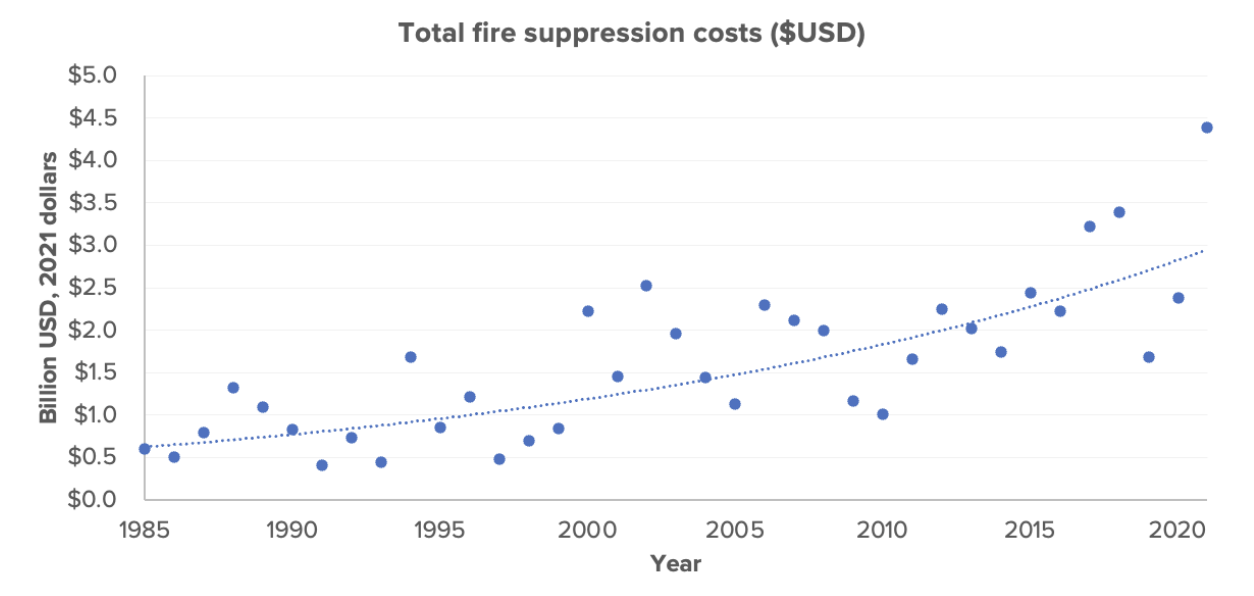
Annual fire suppression costs in the United States. Source: NIFC Data
The USFS costs framework can be used as a baseline for other countries to estimate their own suppression costs. Using the US spending range of $312 to $615 per acre and Copernicus data about the extend of wildfires, the UK can expect to spend between $5M and $45M annually on wildfire suppression, depending on the severity of any particular fire season.Currently, the term ‘wildfire’ is not mentioned once in the London Fire Brigade’s Annual Budget and as of March 2022, the LFB has invested a small total of $1M USD in resilience programs.
The US Forest Service and states have a variety of equipment, including many types of fire engines, bulldozers, crew-carrying vehicles, communication units, construction equipment, helicopters, and more. During the Woolsey Malibu fire, which burned about 4700 acres of land, 1,750 firefighters, about 45 fire engines, numerous hand crews, 23 water-dropping helicopters, and two fixed-wing planes battled the blaze.
In comparison, the LFB dispatched 118 out of 142 total fire engines on July 19 and, at one point, only had three available engines for service. The fire department was limited in manpower and high-tech equipment. Currently, the London Fire Brigade’s vehicles and equipment include aerial appliances, where only three out of nine ladders are based in Greater London, eight command units, and two fire boats. The Woolsey fire exemplifies what preparedness looks like in comparison to the Greater London fires - and highlights the costs that the UK will incur in equipping the LFB for the future.
📍Texas, United States: Coldwaves
Due to rising temperatures in the Arctic and resulting disruption in the stratosphere, coldwaves - the opposite of heatwaves - are becoming increasingly common. In 2021, the disruption within the stratosphere destabilized the polar jet stream, pushing cold air southwards. As a result, Texas recorded its lowest temperature in 72 years, -2°F (-19°C), resulting in 264 deaths and an estimated $300 billion in economic losses.
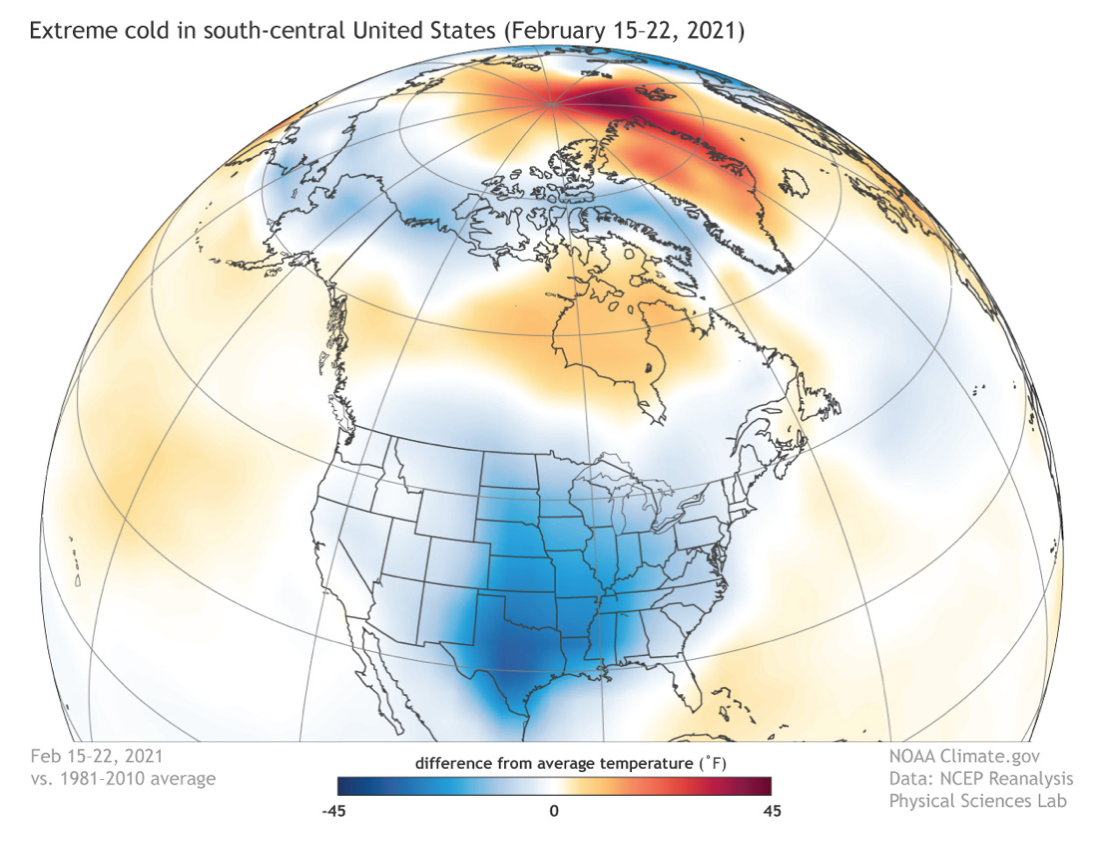
Near-surface air temperatures across the Northern Hemisphere from February 15–22, 2021, compared to the 1981-2010 Average. Source: NOAA Climate.gov
Costs of Adaptation
Texas is the only state in the US with its own electrical grid, meaning that customers depend solely on electricity produced by local power plants. During the extreme coldwave, nearly 70% of Texans connected to their ERCOT grid lost power. In comparison, states like Michigan which experience frequent cold winters have grids linked to multiple states. Since it’s uncommon for all linked states to experience extremely cold weather at the same time, cold-related outages are far less common.
The United Nations Disaster Risk Reduction describes the coldwave in Texas as a ‘cautionary tale,’ emphasizing the need for resilient infrastructure systems investments and designs. Policymakers and energy plants must work together to regulate and implement set goals.

Energy used for home heating, 2020. Source: Data gathered from U.S. Energy Information Administration Texas and Michigan
More than 60% of Texas households rely on electricity for heating, while only one in ten households in Michigan relies on electric heat. Consequently, when electricity demands surged in Texas during the coldwave, its grid was brought to its limits, ultimately leading to a systemic failure. At one point, nearly 48% of power generation capacity was offline, affecting around 3.5 million Texans. Retrofitting Texas’ to be resilient could cost up to $95 million - a cost well-worth it given the economic damage of the last cold wave.
📍Dhaka, Bangladesh: Flooding
Southeast Asia will be among the most vulnerable to the consequences of climate change, and Bangladesh, composed of over 700 rivers with three major rivers running through the country, tops the list of countries at high risk of flooding. Torrential rain that started in April 2022 caused many rivers in Bangladesh to overflow, and by June 2022, 94% of Bangladesh’s Sunamganj town and 84% of the surrounding Sylhet district were submerged.
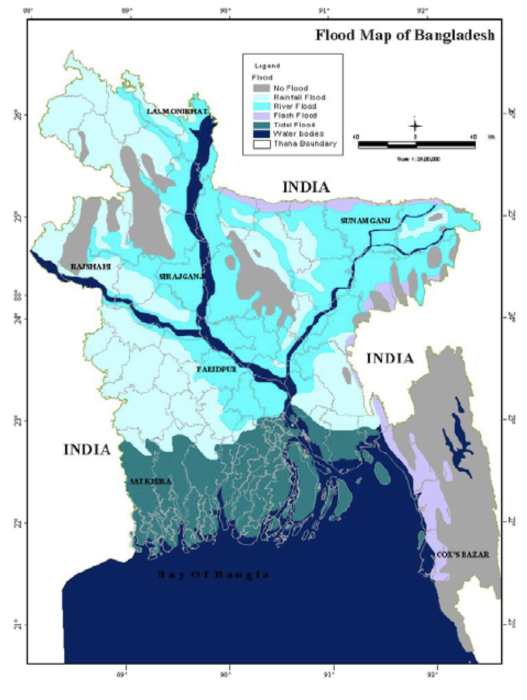
Flood Risk Map of Bangladesh. Source: Climate Change and Water Resources, WARPO
Costs of Adaptation:
People have settled around rivers and other bodies of water for millenia. As climate change becomes more pronounced, flooding risk will dramatically increase. Wealthy nations like The Netherlands have the resources to improve their flood management infrastructure to counteract this increasing risk, but poorer countries lack the resources to do the same. These countries have no choice but to accept either higher levels of flood risk or mass displacement unless resources for prevention and preparedness are made available.
Prevention is the process of designing communities and infrastructure in a way that minimizes the chance of floods. A Flood Risk Management report published in collaboration between the World Bank and local Bangladeshi organizations includes recommendations such as storm drainage systems in rural, poorer areas, and eco-engineered dams and canals. Today, over 78% of the 260 sq. km Dhaka area lack storm drains, and those that exist operate in isolation, meaning that significant work is left.
Preparedness is focused on minimizing the severity of floods. Despite monetary and infrastructure challenges, Bangladesh has improved emergency alerts and shelter capacity. The 2022 floods resulted in far fewer casualties compared to what would have been expected, yet over 7.2 million people still required aid. Permanent solutions require money.
Saleemul Huq, a climate change scientist in Bangladesh explains, “Now what we need countries to do to help us with support, with funding, with technology. We are a poor country. We can't afford to do everything ourselves.”
Developing countries are most at risk for climate disasters, and yet do not have the funds to deploy solutions for prevention and preparedness themselves. Funding will need to come in large part from wealthy nations. Under the Paris Agreement, wealthy countries pledged to provide a total of $100 billion USD to developing countries by 2020. However, much of the pledged aid has still not been disbursed, and the UN estimates that developing countries will need $140-300 billion annually by 2030. Combating climate change is a global issue, which will require all nations to work hand in hand.
Illustration by Stefan Gustafsson of Stefangus Design.
More recent blog posts
28 Sep 2023

ACTUAL Brings Sustainability Transformation Platform to United Nations Global Compact

Dr. Karthik Balakrishnan
+2 more
ACTUAL joins largest corporate sustainability initiative in the world to contribute to the development, implementation and disclosure of responsible business...
19 Dec 2022

Turning over a New Leaf: How FEMA is Addressing Gaps in Tribal Nations’ Disaster Preparedness Planning

Genevieve Olsen
In the wake of increasingly frequent and powerful natural disasters, many Native American tribes and organizations have been vocal about...
19 Dec 2022

To Reach Net-Zero, We Need to Talk About the Maritime Industry

Genevieve Olsen
When we think about reducing GHG emissions, we often think of what’s on land or in the air. But what...